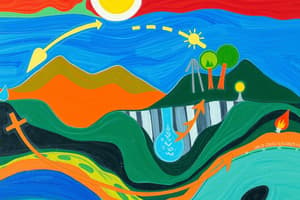Podcast
Questions and Answers
What is the main consequence of adding excess nitrogen to ecosystems?
What is the main consequence of adding excess nitrogen to ecosystems?
- Promotes the growth of algae (correct)
- Increases biodiversity
- Reduces the need for photosynthesis
- Restores balance in ecosystems
How do humans primarily disrupt the nitrogen cycle?
How do humans primarily disrupt the nitrogen cycle?
- By combustion of fossil fuels
- By fertilizing crops (correct)
- By removing trees
- By dissolving nitrogen in water bodies
What is the main element cycled in the nitrogen cycle?
What is the main element cycled in the nitrogen cycle?
- Carbon
- Nitrogen (correct)
- Hydrogen
- Oxygen
Which of the following is NOT a step in the carbon cycle?
Which of the following is NOT a step in the carbon cycle?
What is the term used to describe the process of excessive nitrogen leading to algae blooms and imbalance in ecosystems?
What is the term used to describe the process of excessive nitrogen leading to algae blooms and imbalance in ecosystems?
Which of these human activities contributes to the disruption of both the carbon and nitrogen cycles?
Which of these human activities contributes to the disruption of both the carbon and nitrogen cycles?
What can excessive nitrogen do in an aquatic ecosystem?
What can excessive nitrogen do in an aquatic ecosystem?
What term describes the addition of excess nitrogen to ecosystems through fertilization?
What term describes the addition of excess nitrogen to ecosystems through fertilization?
What can happen when there is excessive nitrogen in an ecosystem?
What can happen when there is excessive nitrogen in an ecosystem?
How do humans contribute to disrupting the nitrogen cycle?
How do humans contribute to disrupting the nitrogen cycle?
Which nutrient is often a limiting factor for growth in ecosystems?
Which nutrient is often a limiting factor for growth in ecosystems?
What is a potential outcome of eutrophication in aquatic ecosystems?
What is a potential outcome of eutrophication in aquatic ecosystems?
How does excess nitrogen in an ecosystem affect the balance?
How does excess nitrogen in an ecosystem affect the balance?
What term best describes the effect of excessive nitrogen on an ecosystem?
What term best describes the effect of excessive nitrogen on an ecosystem?
Flashcards are hidden until you start studying
Study Notes
Cycling of Matter
- Matter circulates between Earth, atmosphere, and living organisms, facilitating biosynthesis and environmental balance.
- Essential elements like carbon and nitrogen are transported and stored through natural cycles, crucial for life.
Carbon Cycle
- The carbon cycle describes carbon movement among Earth, atmosphere, and living organisms, significantly impacted by human activities leading to global warming.
- Key processes in the carbon cycle:
- Photosynthesis: Utilizes carbon dioxide, sunlight, and water to produce glucose and oxygen, reducing atmospheric carbon dioxide.
- Respiration: Organisms intake oxygen and glucose to generate energy, releasing carbon dioxide back into the atmosphere.
- Combustion: Burning of fossil fuels and natural materials that emits carbon dioxide, contributing to atmospheric increases.
- Carbon is foundational for life, forming vital molecules such as nucleic acids, proteins, carbohydrates, and lipids.
Photosynthesis
- Photosynthesis allows organisms to convert sunlight into energy, reducing atmospheric carbon dioxide and integrating carbon into food chains.
- Deforestation disrupts this process, increasing atmospheric carbon by reducing plant-based carbon absorption.
Respiration
- Cellular respiration involves gas exchange; organisms convert glucose and oxygen to energy while releasing carbon dioxide as a byproduct.
Combustion
- Involves burning materials, particularly fossil fuels (coal and oil), releasing substantial carbon dioxide and enhancing greenhouse effects.
Ocean Carbon Cycling
- Oceans act as significant carbon sinks, with atmospheric carbon dioxide dissolving into seawater as carbonic acid.
- Over time, carbonic acid contributes to the formation of limestone, while excess carbon dioxide leads to ocean acidification, potentially harming marine ecosystems.
Nitrogen Cycle
- The nitrogen cycle facilitates nitrogen movement between Earth, atmosphere, and living organisms, essential for proteins and nucleic acids.
- Atmosphere is primarily nitrogen gas (78%), but this form is unusable by most organisms.
Nitrogen Fixation
- Atmospheric nitrogen is converted into ammonia through processes like lightning strikes and bacteria activity, making nitrogen usable for living organisms in soil and plants.
Assimilation
- Nitrogen assimilation involves plant uptake of nitrates for biomolecule production, subsequently passing through the food web.
- Nitrogen return to the soil and atmosphere occurs upon organism death, permitting recycling in the nitrogen cycle.
Studying That Suits You
Use AI to generate personalized quizzes and flashcards to suit your learning preferences.




